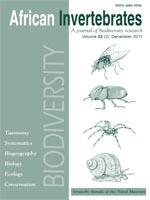I met Anna Dippenaar-Schoeman for the first time in the early eighties at the Johannesburg airport on the way back from a not so successful field trip around the Cape. Instead of writing my name on a piece of cardboard, as is the custom when you meet someone you have never seen before, she had rapidly drawn the outline of a spider on a piece of paper and held it above the other people waiting for acquaintances. That was probably the most efficient way to attract the attention of a fellow arachnologist. So I did not have to enquire whether she was ‘Mrs Dippenaar’, as my predecessor had called her. He had mentioned that she was ‘a promising spider lady’ from South Africa. In his eyes she was in the first place a student of the late Reginald Lawrence. But we would soon learn better.
Ansie, as she insisted to be named, overwhelmed me in the next two days I spent there, with short excursions in the neighbourhood of Pretoria, and meetings with colleagues. She mainly told me of the many plans she had for African arachnology. Although she radiated enthusiasm, I had my doubts about the feasibility. My reservations were not well founded, considering what she had already achieved by then. She was the first African biologist who graduated with a doctoral study on spider taxonomy. Later we found out that she was the first to have used pitfalls for spider studies in Africa, and had already proved the importance of these animals in biological control, long before anyone else in the world had even dreamt of it.
Ansie would become the leading lady for African spider studies in the next three decades, which culminated in her election as president of the International Society of Arachnology (2004–2007), the first woman to be honoured with this position.
The sheer magnitude of what she has achieved can easily be deduced from her impressive CV, and the details do not have to be reiterated here. Highlights doubtlessly include the many books she authored or co-authored and the organisation of the SANSA project, an inventory at a scale that had never been preceded in any country the size of South Africa. However, her CV fails to express Ansie's ability to inspire and motivate people to initiate studies that often seem to be an insurmountable amount of work. If you objected with something like “Yes, nice idea but this involves identification of so many thousands of specimens”, she most often reacted with “Is that all, what's the problem?”.
I was involved in some of her projects, but the books we wrote together were in fact only a small component of what she has accomplished. However, it was then that I experienced how efficient she was. The post-referee stage of our African Spiders book made it clear that we would require a checklist of species per family, which I thought was impossible in that phase of the publication process. “Why not?” she thought, “let's each do half of the work.”. Three days later her list was ready. It was a pleasure to work with Ansie; her efficiency, enthusiasm and perseverance made every project seem achievable, provided one was prepared to contribute one's mite.
There is no doubt that Ansie's contributions have transformed African arachnology, and particularly that of South Africa, from a phase of scattered isolated studies into that of a coherent multi-layered discipline, much earlier than one would have guessed at the time when she started her career.
Against this background, it will not come as a surprise that Ansie's retirement has no other implications than an administrative change and hardly has a bearing on her spider work: she keeps producing spider books and continues to play a key role in the SANSA project. But the event offers an ideal occasion to present the underlying Festschrift as a tribute to her extraordinary career. It is a great pleasure to take part in this initiative together with a choice of fellow arachnologists from around the world, most of them inspired by Ansie's ‘infectious’ enthusiasm for arachnology.






